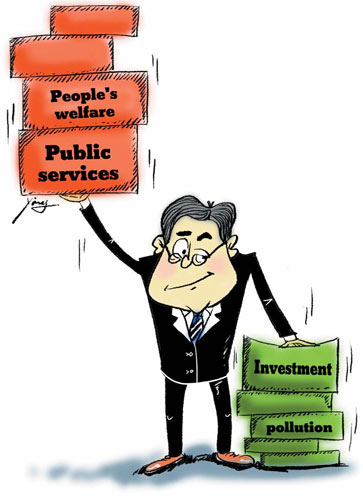Photos
A time to address imbalances
Updated: 2011-03-04 10:24
(China Daily European Weekly)
More determined stance toward inclusive growth, environmental sustainability needed
 |
The annual sessions of the 11th National People Congress (NPC) and the National Committee of Chinese People's Political Consultative Conference (CPPCC) will be anything but ordinary. The typical endorsement of the annual work report of the government and the central and local budgets will be eclipsed by the approval of the 12th Five-Year Plan (2011-2015).
The new plan will roll out the main policy directions for further reform and development in the next five-year period. The document will also include quantitative targets on key economic, social, and environmental indicators, chief among them, GDP growth. As already announced by Premier Wen Jiabao, an annual growth target of 7 percent over the plan's duration has been set to ensure sustainable development.
The target is slightly lower than the 7.5 percent of the previous plan. The downward revision is numerically negligible, and in any event, given the superior rates of actual economic growth, is meant to highlight the government's efforts to sacrifice the speed of growth for the sake of its sustainability.
Critical among the plan's objectives is changing the growth pattern toward a more services and consumption driven model, away from the past emphasis on industrial production, capital investment and exports, which is necessary to address China's social, environmental and external imbalances.
Economic rebalancing was already a key objective in the previous plan, and some progress was achieved in specific areas (for example, curbing energy consumption and pollution, expanding healthcare coverage in urban and rural areas, and increasing public spending on research and development), but there has been limited progress on the overall rebalancing targets. For example, consumption has lagged substantially behind investment, while services have remained at a relatively low level of GDP in spite of its high potential for employment generation.
The need to transform the economic growth pattern is stronger now than it was five years ago, in part because the external imbalances have become more pronounced, and the recent global crisis has highlighted the risks of the export-led growth model.
But rebalancing is unlikely to occur in the absence of bolder policy adjustments. Some of the key policy areas requiring attention include shifting the emphasis of public spending from investment to public services, developing capital markets to help small and medium-sized enterprises and the self-employed to access credit, facilitating greater private sector participation in the economy, and fiscal reform to strengthen local government's sources of revenue.
These complex reforms are expected to be reflected to some degree in the new plan, so the challenge lies in how to successfully implement them. Moreover, the intended reforms, although necessary, are not risk-free, and may create or exacerbate policymaking trade-offs. For instance, promoting services as a source of growth and employment may entail undesired side effects in the short term. These include increased unemployment until the full benefits of the reforms unfold in the medium to longer term, when excess labor is absorbed through the implementation of adequate supportive policy measures (for example, investment in education, vocational training and safety nets).
Besides, making consumption a driver of growth would require large increases in salary, as announced in the plan, which could generate a wage-price spiral in the economy trapping policymakers in a difficult choice between rebalancing and price stability.
Additionally, the new policy framework will have to confront the challenges brought about by the new century, namely the socioeconomic implications of rapid population aging, and the battle against climate change. Notwithstanding the grave consequences of aging at a relatively low level of per capita income, the issue does not feature prominently in the new plan. The document is, however, more vocal on the environmental agenda and builds on solid progress achieved under the 11th Five-Year Plan (2006-2010).
China's rapid economic development has come at significant environmental cost, and rapid economic growth and high dependence on coal as an energy source has resulted in high levels of air and water pollution and rapidly rising carbon dioxide emissions.
Moreover, the prosperity brought about by the successful economic transition has prompted the acquisition of automobiles at a faster pace than infrastructure development that has exacerbated these trends. The 12th Five-Year Plan sets specific green targets, but taking into account the scale of government plans to accelerate urbanization, more efforts are needed to facilitate a sustainable process for this under the framework of a low-carbon economy, including improved water and land management.
Given the depth of the envisaged reforms, the 12th Five-Year Plan is probably one of the most important plans since the foundation of the People's Republic of China. The future of China, however, will depend on reforms that transcend the scope of the current plan.
Looking back, 30 years of successful reform and opening-up has transformed China into the world's second largest economy, which allowed for a swift transition from low-income to middle-income status. Today the challenge lies in how to move up to the level of a high-income country. In pursuit of this, a more determined stance toward inclusive growth and environmental sustainability is needed to secure long-term growth and avoid the middle-income trap.
Great challenges require great efforts. China's strong fiscal position provides ample room to finance the transition to a more balanced and consumption-based growth pattern, supported by increased public spending as intended under the new plan.
Paul J. Heytens is country director of Asian Development Bank's office in China, and Yolanda Fernandez Lommen is head of the economics unit of Asian Development Bank's office in China.
Specials

NPC & CPPCC sessions
Lawmakers and political advisers gather in Beijing to discuss major issues.

Self-made aircraft
An automobile mechanic in Northeast China made a test flight of his self-made aircraft which cost about US$395.

Venetian Carnival
Masked revellers celebrate in Saint Mark's Square in Venice.